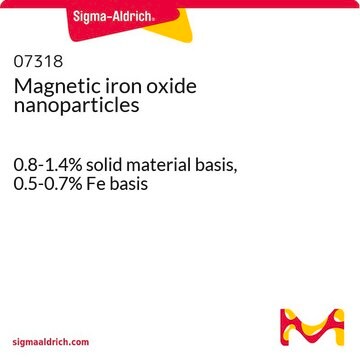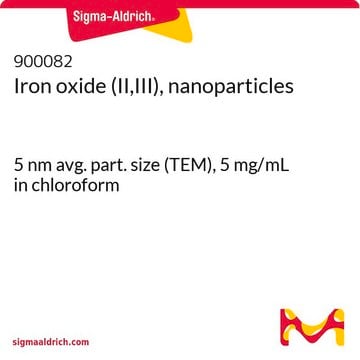The ligand is a modified PEG covalently bound to the inorganic surface by hydroxamic acid.
725331
Iron oxide(II,III), magnetic nanoparticles solution
5 nm avg. part. size, 5 mg/mL in H2O
Sinonimo/i:
Magnetic iron oxide nanocrystals, Magnetite, Superparamagnetic iron oxide nanoparticles
Scegli un formato
About This Item
Prodotti consigliati
Stato
dispersion
nanoparticles
Livello qualitativo
Concentrazione
5 mg/mL in H2O
Magnetizzazione
>25 emu/g, at 4500Oe
Dimensione particelle
4-6 nm (TEM)
Dimens. media delle particelle
5 nm
Densità
1.00 g/mL at 25 °C
Stringa SMILE
O=[Fe].O=[Fe]O[Fe]=O
InChI
1S/3Fe.4O
SZVJSHCCFOBDDC-UHFFFAOYSA-N
Cerchi prodotti simili? Visita Guida al confronto tra prodotti
Descrizione generale
Codice della classe di stoccaggio
12 - Non Combustible Liquids
Classe di pericolosità dell'acqua (WGK)
nwg
Punto d’infiammabilità (°F)
Not applicable
Punto d’infiammabilità (°C)
Not applicable
Scegli una delle versioni più recenti:
Possiedi già questo prodotto?
I documenti relativi ai prodotti acquistati recentemente sono disponibili nell’Archivio dei documenti.
I clienti hanno visto anche
Articoli
Explore DNA-functionalized nanoparticles in sensors for precise target analyte detection. Learn about types, synthesis, functionalization, and design optimization, with insights into challenges and prospects.
Professor Mitsuhiro Ebara provides insights on several types of smart nanofiber mesh systems that have been explored for different drug delivery purposes.
Professor Hui Mao explores the use of superparamagnetic iron oxide nanoparticles (INOPs) that offer an alternate contrast-enhancing mechanism.
Prof. Yadong Yin discusses various synthesis methods of magnetite nanocrystals and their applications in different fields.
-
What is the surface ligand for the Fe3O4 nanoparticles (725331-5mL)?
1 answer-
Helpful?
-
Active Filters
Il team dei nostri ricercatori vanta grande esperienza in tutte le aree della ricerca quali Life Science, scienza dei materiali, sintesi chimica, cromatografia, discipline analitiche, ecc..
Contatta l'Assistenza Tecnica.

